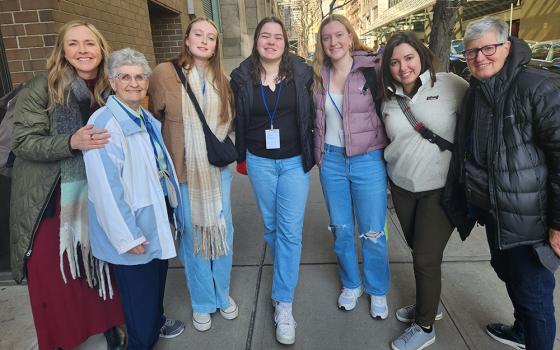Case studies from the fringe underlie analysis of women in Catholicism
WOMEN & CATHOLICISM: GENDER, COMMUNION, AND AUTHORITY
By Phyllis Zagano
Published by Palgrave Macmillan, $28
Phyllis Zagano has long been a careful and reasonable voice, active in both scholarly and media conversations about Catholicism. Author or editor of more than a dozen books and numerous scholarly articles, particularly in the field of spirituality, she has turned her talents in recent years more often to questions about the church and the role of women. (Her blog, Just Catholic, appears on the NCR Web site.)
Thus my first impression, scanning the table of contents for this latest offering, was puzzlement. This is a writer who championed the ordination of women to the diaconate but oh-so-carefully side-stepped the question of the ordination of women to the priesthood (Holy Saturday: An Argument for the Restoration of the Female Diaconate in the Catholic Church, Crossroad). This is the writer who highlights the giants of the great spiritual traditions of the West (the Spirituality in History series, Liturgical Press) and responds directly to the times with a tender and straightforward handbook for starting a prayer life (On Prayer: A Letter to My Godchild, Ligouri).
That was then. Her current study finds her hanging out with Lincoln, Neb., Bishop Fabian Bruskewitz, Call to Action, the Society of St. Pius X, Married Priests Now!, Roman Catholic Womenpriests, and the simply weird case of Archbishop Emmanuel Milingo of Lusaka, Zambia -- healer, exorcist and on-again, off-again spouse. Somehow Zagano seems to have moved from the nourishing soup of history and prayer straight to the macadamia nuts.
All these players form a series of three “case studies” that have common themes, Zagano claims: internal communion, hierarchical authority, and gender. In the first, we are introduced to Bruskewitz, who came into office brandishing antifeminist tracts, rejecting the notion of altar girls, and, finally, issuing his famous decree of automatic excommunication for Catholics in the diocese who were members of any of a dozen groups he found to be problematic. Zagano teases out the canonical niceties of this (the bishop did not sign this piece of legislation?) and traces the rise of Call to Action along the way, noting that the bishop seemed to be most annoyed when Call to Action Nebraska (already banned from his diocese) would feature women religious as speakers. When the sex abuse crisis breaks, Bruskewitz breaks with the U.S. Conference of Catholic Bishops, finding that their common efforts would impinge on his rightful authority over his diocese. His touchstone is the juridical; he reports only to Rome; the notion of internal communion seems to mean little to him.
 In the second scenario, communion and authority are clearly at issue, as Milingo exercised a popular but controversial ministry as healer and exorcist in Zambia, running afoul of the Vatican and his fellow African bishops for flouting the norms for exorcism, under the banner of inculturating Catholicism for African believers. That was just phase one. In “retirement” in Rome, he married Maria Sung, a Korean woman, in a mass wedding under the banner of the Unification Church; renounced his wife for several years; then re-appeared as the initial organizer for a movement based in the U.S. called Married Priests Now!, still married (or remarried?) to Sung. It would seem that sex, not gender, has now been introduced -- except for Zagano’s careful examination of Milingo’s rationale for married priests. You can read the rest.
In the second scenario, communion and authority are clearly at issue, as Milingo exercised a popular but controversial ministry as healer and exorcist in Zambia, running afoul of the Vatican and his fellow African bishops for flouting the norms for exorcism, under the banner of inculturating Catholicism for African believers. That was just phase one. In “retirement” in Rome, he married Maria Sung, a Korean woman, in a mass wedding under the banner of the Unification Church; renounced his wife for several years; then re-appeared as the initial organizer for a movement based in the U.S. called Married Priests Now!, still married (or remarried?) to Sung. It would seem that sex, not gender, has now been introduced -- except for Zagano’s careful examination of Milingo’s rationale for married priests. You can read the rest.
Sex and gender, in these, are the undeniable flash points. But in a deep way, Zagano documents, these cases are really asking, “What does it mean to be in communion with the ‘Chair of Peter’?” These and the many other parallels she cites do make for a curious collection of bedfellows. Why drag them out? To set up her real argument, put forward in a third scenario, about women’s ordination.
Zagano traces the rejection of women’s ordination through its recent history, as it has shifted from a primarily theological basis to the current position, which rests on an argument from authority, an authority newly constructed just for this instance, it would seem -- and one that devolves, she traces devastatingly, to a grasping at administrative straws. What is most helpful about this chapter is the way in which she sets this well-trodden ground in the constellation of practices in the wider Catholic community, pulling depth and breadth from her analysis as she goes. At the end, she asks for renewed consideration of the question of the ordination of women to the priesthood, though her real action item is the restoration of the female diaconate.
Her arguments are persuasive, though I disagree strongly when she predicts that ordaining women to the diaconate would “help the Catholic church regain its perceived lost authority in matters of human rights and equality.” It won’t, but that doesn’t mean it isn’t a good idea.
This slim volume, one-third of which is given over to notes, presents these cases at a quick clip. Zagano’s commitment to doing her homework is on full display as she ably synthesizes journalism, canon law, ecclesiology, and a solid working knowledge of church practice. It is helpful that, in a book that focuses on borderline cases, she seems committed to not taking sides. But still. Should we simply equate clerics in the Womenpriests movement with the clerics of the Society of St. Pius X? Is the basic parallel between Bruskewitz and Milingo that they don’t play well with others? And while internal communion does indeed find its center in the Chair of Peter, do we understand that center to be grounded in the communion (or “above the fray”)?
In the final analysis, the first two scenarios stand apart from the third. We get the point -- disturbing ideas about women and sexuality crop up with predictable frequency among seemingly disparate problem cases in the church. And the rejection of the ordination of women does have to do with the fact that those rejected are ... women. But the implied causal connection is not linear; the dynamics of gender in religion have both public and private overtones that constantly over-determine their analysis; and, theologically, it is not the case that the rejection of women for ordination is simply misogynist. Thus I find it a little misleading to simply line these scenarios in a row and turn to the audience with a knowing glance.
Bottom line: When the Catholic theory of everything is written, these characters will all have a place, and Zagano knows where to start. But that will require a longer book.
[Nancy Dallavalle is associate professor and chair of the department of religious studies at Fairfield University in Connecticut.]


